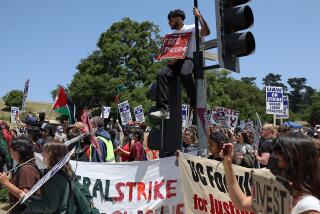Their Weapon Against Gangs Is Knowledge
While most city police investigators spend their shifts chasing suspects and getting tough on gangs, Michael Aquino is paid to talk to kids.
The gang investigator spends his time patrolling Anaheim Union High School District campuses, counseling teenagers on how to avoid the gang life and advising teachers to recognize trouble before it explodes.
The joint program between the district and the Anaheim Police Department teams Aquino full time with a former high school history teacher. Together, Aquino and Rick Krey pop into lunchrooms and faculty lounges, and show up unexpectedly at gang hangouts near the city’s schools.
With Krey along to identify teens and their schools--and to ease Aquino’s dealings with school officials--the two focus on cutting gang activity before there is a need to make arrests.
“In our opinion, gangs are like drugs,” Aquino said. “It’s not like kids just walk out one day and become hard-core gang members. It’s a peer pressure thing. But unfortunately for a lot of these kids, once they’re in, there’s no way out.”
The program, which police officials consider a model of community policing, seems to work.
Since it was instituted in 1993, crime on campuses is down 49%. Last year, the U.S. General Accounting Office studied more than 250 school safety programs nationwide. It cited Anaheim and three other districts as best.
On a recent day, Aquino and Krey found themselves in a school principal’s office with the choice of arresting a seventh-grader or advising him. They chose to talk.
The teenager had been carrying a set of interlocking rings that school administrators believed were brass knuckles. But the youth, who had never been in trouble with the law before, said he thought the item was jewelry and didn’t realize it could be used as a weapon.
“I’m not going to arrest you, because I think you’re probably a pretty decent kid,” Aquino told the youth after speaking with him for about 15 minutes and satisfying himself that he wasn’t dealing with a gang member.
“If you were a hard-core gang member it would be a different story. Now, let’s talk about your grades. . . .”
The session with the youth was typical of the program’s approach.
“Both of us were raised right here in the city,” Krey said. “We know what it was like to grow up in this town when there were no gangs, and when it was really fun to be a kid. What motivates us? We want kids to be kids.”
The program owes its beginnings to a grant from the U.S. Department of Justice. But since 1994 it has been funded by the school district and the Police Department. Aquino and Krey have desks at police headquarters and at an Anaheim high school.
And while only Aquino carries a gun and Krey has no authority to make arrests, the program is very much a creature of the two men, both graduates of Anaheim high schools.
“They work about 12 hours a day on every single thing on the campuses, and they seem to have a finger on everything that’s going on,” said school board member Slim Terrell. “They have put their hearts and souls into these children to try to make a difference in their lives.”
The program has been so successful that it may be expanded.
At a study session in May, the school board will discuss a proposal to assign more police officers to campuses. Currently, Aquino and Krey patrol all 16 high schools and junior high schools in the district. Another police officer monitors drug use and crime at several of the city’s toughest schools under a three-year California state grant.
Krey and Aquino do more than deal with kids in trouble. They explain to parents how to recognize signs that their children are in gangs. They help school administrators formulate dress codes that prohibit gang attire, and they hold classes and seminars on gang awareness.
“A few years ago, a gang was really tagging our campus. The regular police just came and took a report,” said Hank Frese, principal of South Junior High school. “When Rick and Mike came out, they knew what school the kids causing the problem were from, and that’s when we started to crack it. It’s that follow-up that makes the difference.”
More to Read
Start your day right
Sign up for Essential California for news, features and recommendations from the L.A. Times and beyond in your inbox six days a week.
You may occasionally receive promotional content from the Los Angeles Times.






